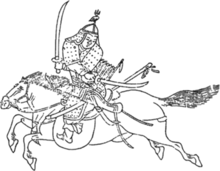Muye Dobo Tongji
| Muyedobotongji | |
 |
|
| Korean name | |
|---|---|
| Hangul | 무예도보통지 |
| Hanja | 武藝圖譜通志 |
| Revised Romanization | Muyedobotongji |
| McCune–Reischauer | Muyedobot'ongji |
Commissioned by King Jeongjo (r. 1740–1810) in 1790, the Muyedobotongji (or Muye Tobo Tong Ji, translating to "Comprehensive Illustrated Manual of Martial Arts") expanded on the eighteen weapons systems identified in the Muyeshinbo of 1758.
Written by Yi Deokmu (이덕무, 1741–1793), Pak Je-ga (박제가, 1750–1805) and Baek Dong-soo (백동수, 1743–1816), and published in four volumes in 1795, it preserved the methods and practices of the earlier work while adding equestrian training by executing six of the earlier weapons on horseback (마상육기 馬上六技 or 마상6기), extending the system to "twenty-four [martial arts] methods" ([무예]이십사 / [武藝]二十四技)
While little more than a field manual for cataloguing required skills, the Muyedobotongji is widely regarded as a resource for understanding the nature of Korean military science in the 18th century.
As a result of the high frequency of warfare experienced in Northeast Asia, and in particular the destructive nature of the large number of invasions suffered by the Korean Peninsula, the majority of any documentation of Korean indigenous martial techniques and combat styles has been lost. Much of modern-day scholarship related to the classical or pre-modern Korean martial arts, in particular those that predate the Mongol invasions of Korea (during which Korean palaces and libraries that would have contained many documents germane to the study of martial arts and combat self-defense were destroyed), relies on the study of the Samguk Sagi compiled by the scholar Kim Bu-sik and the Samguk Yusa compiled by the Buddhist monk Iryeon. Both works suggest that militant attitudes between and among the three major nations of the Korean Three Kingdoms Period (37 BCE - 660 AD) resulted in each nation developing an institution for training its warriors in martial arts and military sciences.
The end of vassaldom to the Mongol Yuan Dynasty in the mid-1300s did not bring peace to the Korean Peninsula. The withdrawal/retreat of Mongol hegemony roughly coincided with the collapse of the Kamakura Shogunate in Japan; the resultant instability and the relative lack of control exerted by the subsequent Ashikaga Shogunate led to an increase of incursions by coastal raiding forces, mostly from the Japanese islands. These pirate attacks, as well as raids from the uncontrolled regions in southern Manchuria, provided the Korean state (first as Goryeo and later as Joseon) with some rationale for rebuilding Korean military installations and units. However, as a whole, the ascendance of the Joseon Dynasty in Korea in 1392 and the installation of Neo-Confucianism as its guiding philosophy meant that academics, civil pursuits, and cultural arts were overwhelmingly emphasized at the expense of martial arts and military pursuits. As a result, many national and local defense structures, as well as the training and practice of armed combat, was limited and just sufficient to repel small-scale raids and tribal attacks.
...
Wikipedia
